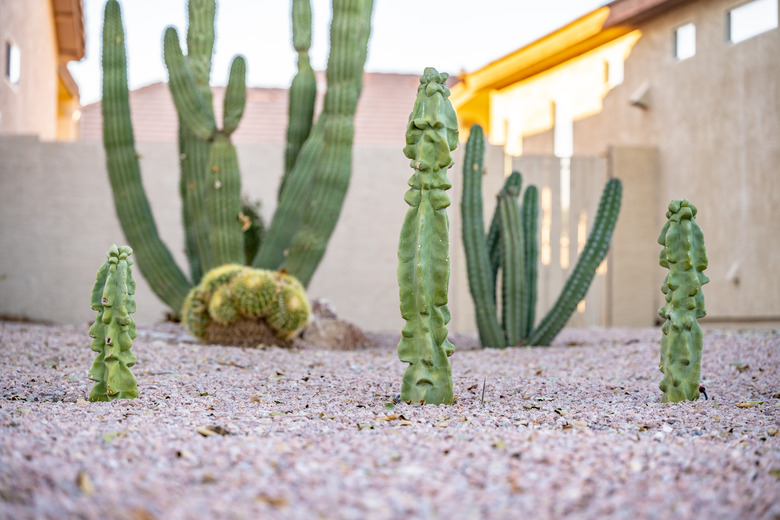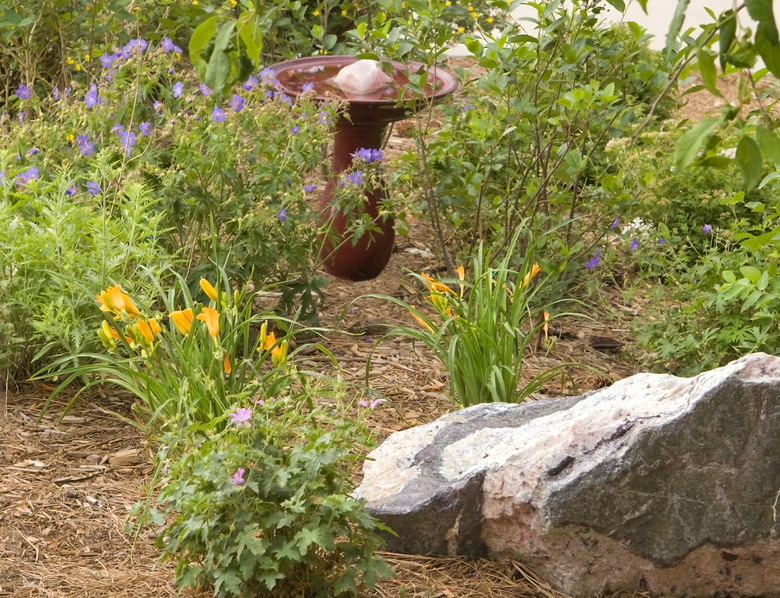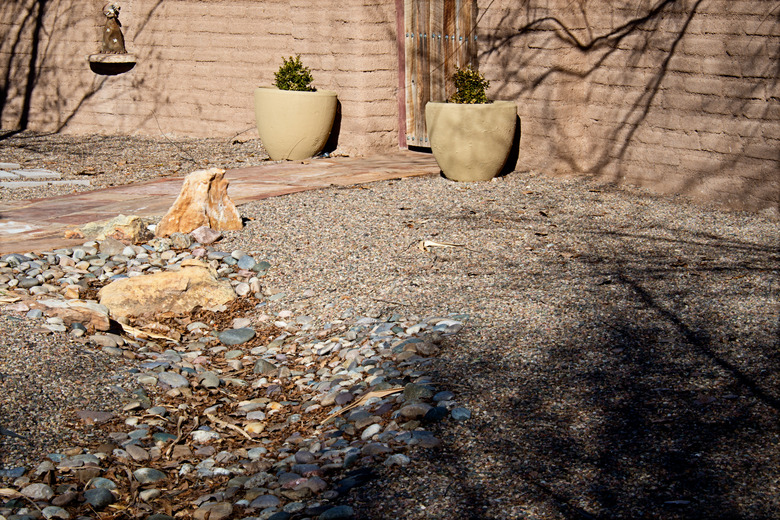Tips For Designing A Xeriscape Garden
If you live in a dry climate, chances are you've heard of xeriscaping, and you may have a vague sense that it's something you should do but probably don't want to do. Much of the negative stigma of xeriscaping is due to the impression that it's all about desert plants — yucca, cactus, Joshua trees, etc. — and acres of gravel and rock. But there's much more that you can do with xeriscape design, and it's not just for dry climates.
Yes, the central idea is low water use (and typically low-maintenance), but that doesn't mean a water-wise landscape has to look like the movie setting for an old Western. A properly xeriscaped yard not only looks great, it also saves water, money and time. Now, doesn't that seem like something you might actually want to do?
Principles of Xeriscaping
The term xeriscape is based on the word xeric, which describes plants or environments that require little water or moisture. Likewise, the goal of xeriscape design is to create a landscape that—once established—needs little added water beyond what is provided by natural precipitation in a typical year. In unusually dry years, more irrigation may be necessary.
Xeriscaping is not based on a particular style or look, and it is not limited to specific plants and other materials. Instead, it is a landscaping strategy consisting of seven basic principles; any garden or landscape that adheres to these principles is considered a xeriscape, regardless of the aesthetic treatment or any plant species used:
1. Planning and Design
Drawing up plans of the site, including all existing plantings and structures, is an important first step in any landscape or garden design. It helps you assess what you have to work with and visualize the changes you'd like to make. In the case of a xeriscape, plans help to identify natural conditions, such as water runoff, sunlight and shade, or existing problem areas—information that may be helpful in determining how to group plants for suitability and water needs, as well as for maximizing aesthetic and functional benefits.
Soil composition affects how well the ground accepts and holds onto water. If you try to grow drought-tolerant plants on the wrong type of soil, they may turn out to be much more water-hungry than expected, defeating the purpose of xeriscaping. Soil should be amended (usually with natural compost or other organic matter) as needed for specific plants before planting begins. On the other hand, plants that are native to your area might be fine in poor soil or the native soil that is standard for the region.
Making the most of the water you use is central to xeriscape design. An efficient watering system is the opposite of a "one-sprinkler-fits-all" approach and typically incorporates drip and low-flow spray emitters, soaker hoses, efficient grass sprinklers, and automatic timers that water at ideal times of the day (to minimize evaporation). Watering system design ties in with plant selection and grouping so that watering is specific to each planting area, or zone.
The basic concept of zone planting is to group plants with similar water and care needs and to locate each zone to reduce maintenance as much as possible. For example, plants with somewhat higher water needs or those that benefit from periodic heavy moisture should be located in low-lying areas or where they're periodically flooded by downspouts during a rain. Zoning doesn't have to mean all of the plants in a given area are the same type of plant. In fact, it's usually best to vary the types of plants within each zone to create interesting textures and color combinations.
Mulch, such as wood chips, bark, stone and many other materials, reduces water use by shielding the soil from sunlight and minimizing evaporation, helping the soil retain moisture longer. Mulch also inhibits weeds (which rob water from other plants and are a maintenance problem) and protects plants from extreme heat. Instead of covering the spaces between your plants with living ground cover or grass—or leaving it bare—cover it with a thick layer of mulch to provide all these benefits, as well as to create an attractive look.
Xeriscaping doesn't mean you have to get rid of all of your grass. Turfgrass is desirable and useful, but it does require a lot of water and maintenance. Therefore, a xeriscape usually includes relatively small, well-tended and well-used areas of turf rather than a lot-to-lot carpet of grass.
In addition to shrinking turf areas to a practical size, it's best to plant grass that thrives with minimal watering in your climate. For example, in the arid western states, buffalo grass, blue grama grass and certain fescues fare better with less water than a suburban standard such as Kentucky bluegrass.
Watering is one form of maintenance, so planning for less water use also cuts down on your maintenance time. Likewise, plants that need less water also tend to need less pruning, deadheading, cold and wind protection, pest control, and other forms of care. All of this is consistent with the overall strategy of xeriscape design: less water, less time, less care.
Hardscaping in a Xeriscape
Xeriscaping is all about low-water-use plants and efficient, low-maintenance design. Hardscaping — rock, gravel, concrete, walls, fences, driveways, etc. — may be an important part of a xeriscape, but it doesn't have to be. It is a common misconception that xeriscapes must contain significant hardscape elements. In reality, what matters most is using materials that complement the plants.
A desert-style garden with succulents, barrel cactus and desert flowers looks stunning on a backdrop of curving swaths of crushed stone or broad stepping blocks, while a Tuscan-style xeriscape is perfectly anchored by a dry-stacked stone wall reminiscent of an Italian farm border.
Of course, some hardscape materials such as gravel and stone ground cover, are exceptionally low-maintenance; they don't break down like natural mulches, and they're much less hospitable to weeds. This is certainly one reason why these are popular in xeriscapes. Another effective use of hardscaping in a xeriscape is driveway, patio and walkway surfaces that shed rain and snowmelt onto planted areas rather than flowing onto the street and ultimately into the storm sewer. Keeping surface water on the property is a classic water conservation technique, and it fits perfectly with xeriscape strategy.
Selecting Plants for Your Xeriscape
As with hardscaping, choosing plants for xeriscapes is less rigid or limited than many people assume. For one thing, you don't have to restrict yourself to native plants. Non-native species that have been successfully introduced into the local climate are fair game, as long as they don't need a lot of water or a lot of care.
The best place to get recommendations for plants that are truly drought-tolerant and appropriate for your climate is a local University Cooperative Extension Service office. If you live in a dry climate or any area with water restrictions, there are also likely to be plenty of additional sources for xeriscape plant advice, such as local water utilities, city or state governments and water-conservation organizations. All such local sources will know what grows well in your climate.
One of the primary reasons that conventional landscapes use so much water is that they utilize plants from other climates—climates that have more natural precipitation. Tulips may invoke images of misty Dutch landscapes, but they also can be a great choice for adding color to a xeriscape. Same goes for some roses, irises and many other flowers. If you use these plants in drier areas, you may have to make up the difference with irrigation, and even then they may struggle unless you add a drip-watering system, which applies water directly to the root balls of the specific plants.
One thing to keep in mind when selecting plants for drought-tolerance is that new plants from a garden store or nursery often need extra watering in their developing years, and they become more drought-tolerant over time. By contrast, plants of the same species growing naturally have already adapted to their environment and are drought-tolerant from an earlier age. Most low-water-use plants need a lot more water in the first year or two than they do when they're mature.




